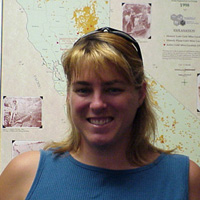 Three dimensional elemental mass transfer during development of saprolite from corestone: Santa Margarita Ecological Reserve, Temecula, CaliforniaCindy Earl Monday, May 9th, 2008 |
||
|
||
| ABSTRACT Our understanding of the characteristics of chemical weathering in a Mediterranean (hot summer) climate has increased significantly over the last few years. For example, we now know that as quartz dioritic corestone is converted to saprolite in this climate, biotite expands and weathers to mixed-layer clays while plagioclase and amphibole play much less significant roles. However, there have been no studies that have investigated the three dimensional aspect of this weathering trend. Hence, I undertook a study that utilized the previous work of Chris Martinez to constrain the horizontal aspects while I focused on assessing the relevance of this trend along a vertical sampling traverse through the same corestone-saprolite pair. I collected 9 specimens, 5 from the corestone and 4 from the saprolite, spaced approximately equally, along a 1.2 m vertical traverse. Each sample was thin sectioned for petrological work and was analyzed for major and trace elements using standard XRF methods. Samples of the corestone are hypidomorphic granular quartz diorites that exhibit little evidence of chemical alteration. In thin sections, euhedral to subhedral biotite exhibits deep brown pleochroism, sharp traces of the {001} cleavage, and typical “birds eye” extinction. Similarly subhedral plagioclase exhibits well developed polysynthetic twinning and concentric compositional zones, while amphibole commonly displays cleavage parallel to {110} at angles of 56o and 124o. In contrast, in saprolite overlying the corestone, the {001} cleavage in biotite becomes less distinct while pleochroism takes on pale orange hues. S. Johnson showed that these characteristics reflect the transformation of biotite to mixed layer expandable clays. Unlike biotite, both plagioclase and amphibole exhibit only mild indications of weathering, while quartz remains unweathered. The average Chemical Index of Alteration (CIA) for corestone samples analyzed during this study is 60.0 ± 0.1 (95% confidence interval) and for saprolite is 60.9 ± 0.5 (95% confidence interval). In A-CN-K ternary space, samples of the corestone plot below and more toward the K-apex than do specimens of saprolite which plot close to the A-CN join. Moreover, τ, the transport function, suggests that the masses of Si, Fe, Ca, Na, Mg, and Mn changed little relative to their masses in the average corestone. In contrast, the masses of K, Rb, and Ba are depleted significantly in the saprolite. Volumetric strain, ε, for the four samples of saprolite ranges from 16% to 21% while porosity ranges from 14.5 % to 16.5%. In contrast, there is little significant change in bulk mass in going from the corestone to the saprolite. The above weathering trends are similar to those documented by C. Martinez, and thus suggest that saprolite development from corestone is a three dimensional process that in Mediterranean (hot summer) climates depends primarily on the expansion and alteration of biotite to mixed layer expandable clay. Apparently, during this process stresses are produced that are sufficiently large enough to break or weaken adjacent intercrystalline bonds. Given sufficient time, this process will render solid and hard quartz diorite to saprolite, a weak material that breaks easily under moderate finger pressure. |

